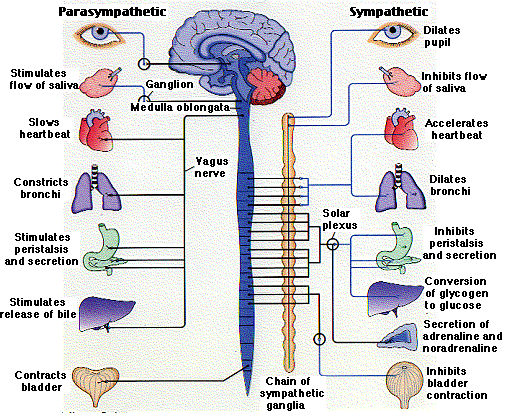Neurotransmitters
Chemical Signaling Between Cells-types of chemical signaling are Neurotransmitters , local mediators and the secretion of hormones .
-All are too hydrophilic to penetrate the lipid bilayer of target-cell plasma membranes.
A. Local mediators
-Most cells in the body secrete chemicals that act locally.
-rapidly destroyed or removed
-do not enter the blood and are not distributed throughout the body ex:- Histamine and the prostaglandins.
B. Hormones
-secreted from Specialized indocrine cells
- enter the bloodstream where they travel throughout the body exerting effects on broadly distributed target cells in the body.
C. Neurotransmitters
-Communication between nerve cells and between nerve cells and effector organs occurs through the release of specific chemical signals, called neurotransmitters.
-Types of neurotransmitters
norepinephrine (and the closely related epinephrine), acetylcholine,
dopamine, serotonin, histamine, and GABA.
-The autonomic nerve fibers can be divided into two groups based on the chemical nature of the neurotransmitter released.
-If transmission is mediated by acetylcholine, the neuron is termed cholinergic
-if norepinephrine or epinephrine is the transmitter, the fiber is termed adrenergic (adrenaline being another name for epinephrine).
Acetylcholine mediates:
-the transmission of nerve impulses across preganglionic neuron in both the sympathetic and parasympathetic
-Transmission from the autonomic postganglionic nerves to the effector organs in the parasympathetic system
and a few sympathetic system organs
- transmission In the somatic nervous system, transmission at the neuromuscular junction (that is,
between nerve fibers and voluntary muscles)
Norepinephrine and epinephrine mediate :
-the transmission of nerve impulses from postganglionic neuron of sympathetic to effector organs .

Chemical Signaling Between Cells
local mediatorsمن أنواعها النواقل العصبية والهرمونات و
ِA-local mediators
ودى بتتفرز من بعض الخلايا وبتدى تأثيرها فى مكانها وبتتكسر فى مكانها
عشان كده مش بتوصل للدم
B. Hormones
بتتفرز من خلايا معينه زى الغدد وبتوصل لمكان التأثير بتاعها عن طريق دخولها فى الدم
C. Neurotransmitters
ودى هى اللى بتوصل الاشارات بين الخلايا العصبية وبعضها وبين الخلايا العصبية والاعضاء وأمثلة عليها
norepinephrine (and the closely related epinephrine), acetylcholine,
dopamine, serotonin, histamine, and GABA.
dopamine, serotonin, histamine, and GABA.
nerve fiber اسم ال
بيعتمد على الناقل العصبى اللى خارج من نهايته
acetylcholine لو المادة اللى خارجة
cholenergic يبقى العصب اسمه
norepinephrine or epinephrine لو المادة اللى خارجة
adrenergic يبقى العصب اسمه
Acetylcholine mediates:
-the transmission of nerve impulses across preganglionic neuron in both the sympathetic and parasympathetic
-Transmission from the autonomic postganglionic nerves to the effector organs in the parasympathetic system
and a few sympathetic system organs
- transmission In the somatic nervous system, transmission at the neuromuscular junction (that is,
between nerve fibers and voluntary muscles)
Norepinephrine and epinephrine mediate :
-the transmission of nerve impulses from postganglionic neuron of sympathetic to effector organs .
adrenergic يبقى العصب اسمه
Acetylcholine mediates:
-the transmission of nerve impulses across preganglionic neuron in both the sympathetic and parasympathetic
-Transmission from the autonomic postganglionic nerves to the effector organs in the parasympathetic system
and a few sympathetic system organs
- transmission In the somatic nervous system, transmission at the neuromuscular junction (that is,
between nerve fibers and voluntary muscles)
Norepinephrine and epinephrine mediate :
-the transmission of nerve impulses from postganglionic neuron of sympathetic to effector organs .





